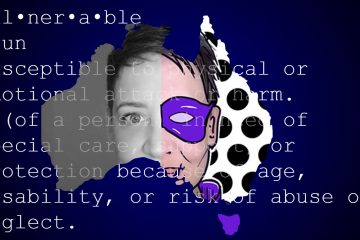I woke up this morning with a headache, it wasn’t a big deal and it went away after I took regular, straightforward over-the-counter painkillers. When I showered, I found a very tender, and extremely large bump on the back of my head. Immediately I started joining dots together and the headache I’d had on awakening was, perhaps no longer just a headache. It was now a leftover from what may well have a been seizure-related fall, stumble or collision. My frustration is I don’t have the answer to this mystery. I never will.
My first plan (as always) was to hunt the flat for signs of anything out of place; was any furniture knocked over, did anything look even slightly unusual? But everything appeared to be as it was last night. This served only to feed my frustration. It’s exasperating to wake with the wounds of an energetic acrobatic performance and have no memory of them. But that’s my life with epilepsy. Every now and again I’m forced to play Poirot, faced with a seemingly impossible mysterious incident, and then (case unsolved) I move on. Safe in the knowledge there’ll be another one.
It hasn’t always been this way; it isn’t always this way. I’d be lying if I said life with epilepsy is about getting used to it, getting on with it. It’s not. There’s no golden secret, no key to happiness but you can be happy. In fact, you can be anything you want to be. I’m an epilepsy veteran, I was officially diagnosed in 1991, at 13. I put it this way because my diagnosis didn’t follow my first seizure, it didn’t even follow my second. I am of the belief I’ve been having seizures (if not always), at least since I was 4.
After 30 years of having seizures the string vest my memory has become has blurred the details about how I was diagnosed. I’m sure I was 13 and I know it was at Great Ormond Street Hospital; what I’m certain of is how it made me feel. I remember feeling lost and alone; it was like I had been abandoned to fight an enemy much bigger than I was, and I shouldn’t, I couldn’t ask for help.
I was now officially different. And it’s hard to stand out from the crowd. It’s even harder when the reason you’re standing out isn’t ‘ooooh-look-at-her-she’s-amazing’ it’s ‘ooooh-look-at-her-that’s-weird-why’s-she-doing-that?’ Add to that the fact I was 13, puberty was just kicking in, bringing with it the special brand of nightmare only adolescence brings. I didn’t stand a chance.
What I should have done is speak up. What I needed was guidance, more information. It felt like I had changed; like I was broken. I brazened my way through high school. I just put on a brave face and smiled; I was top of the class and appeared happy. But this meant I didn’t get the help I desperately wanted and needed. My high school memories are peppered with embarrassing moments and that’s not how it should be. At this point I was having giggling (gelastic) seizures, which meant my events involved a loud and uncontrollable cackle. It sounded like a bad impression of Eeyore.
By my late teens, I’d had enough. It seemed unfair that all my life I was the one who stood out from the crowd. Not in the ‘OMG, look who’s just walked in; I think that’s [insert your celeb of choice here]’ type way. I’m talking about the ‘OMG, I’ve fallen, I’m bleeding, I’ve pee’d my pants and now everyone’s staring and laughing’ type way. None of my mates had to take medication, why was this happening to me?
I felt like the only person in the world with epilepsy.
I was taking pills that didn’t seem to be doing anything, every morning and every night I’d swallow tablets and yet I still had seizures; why was I bothering? So, I stopped. No doctor told me to, no medical advice, I just stopped.
3 days later I was found unconscious, unreactive and stayed that way for almost a week. When I did ‘come to’ it was a ‘not-quite-version’ of me. I didn’t recognise my family as my family. I couldn’t perform every-day routines I’d previously had no problems with, like using cutlery for instance. It was as if part of my brain hadn’t restarted. For just under a year my family made sure I wasn’t alone, it wouldn’t have been safe.
Ultimately, that part of my brain (which I obviously needed to have a personality) restarted and when it did, I was annoyed. I was infuriated. And looking-back-at-it-now-sensible-I’ve-got-a-hold-on-this-Goldilocks can see I was angry at myself. But 19-years-old-I-know-everything-Goldilocks didn’t think like that. All I was thinking then was: ‘if this is how my life is going to be, I’m not doing it here, I’m doing it in Australia!’. And I left. I left the family who’d cared for me 24 hours a day for the last 9 months. I travelled on a 1-year work visa and eventually stayed in Australia for 12 years.
To all intents and purposes, I reinvented myself in Australia. In the UK I was Goldilocks with epilepsy, I was determined to be just another Brit’ in Australia. I took my medication, after the experience I’d just had, I was too frightened not to. However, I only shared my diagnosis with a very select few. I ignored epilepsy. I went out of my way to make it a non-thing. I would at the very least keep up with my friends, but more-often-than-not I’d set the pace.
Every 6 months or so in those first 6 years I’d have a generalised seizure (usually seizures) which required a hospital admission. In that I hadn’t shared this condition with anyone, I’d be alone, and as great as the docs and nurses are, being alone in hospital sucks. But still I told no one. I was in denial; a part of me (actually) believed if I ignored epilepsy, it would go away. Like a child who covers their eyes while playing hide-and-seek, with the misguided notion of ‘if I can’t see you, you can’t see me’.
In 2011 my seizure frequency increased, and the seizures changed, I was having 1-2 focal impaired awareness seizures each week. I knew I needed to head back to the UK, I craved the support of my family; May 2012 I landed at Heathrow.
But profoundly deep-rooted denial doesn’t fade overnight. I began working full-time and didn’t even consider new treatments or start to investigate adjusting my medication. It took me months to even register with a GP. I was more open about my condition; epilepsy played that card for me. In that I was having daytime events it was plausible, even probable I’d have one in the office. And I did, several times over.
I finally got to a neurologist and underwent all the acronyms: EEG (electroencephalogram); CT (Computed Tomography); and MRI (Magnetic Resonance Imaging). There was also a 3-day EEG telemetry, where the EEG wires are glued to your barnet and you’re watched on video-cameras all day and all night. As always (for me) these tests didn’t identify where my epilepsy is or why I have it.
And as always, that was frustrating.
For the first 5 years of being home in the UK I struggled, I refused to give in; I saw that as weakness, as being different. I’d conceded (slightly) and reduced my hours at work from full time to 18. I felt if I could have enough rest days in-between then I could remain at work, I could be like everyone else, be self-sufficient. In 2017 it was taken out of my hands. I’d ended up at the doc’s one morning because of a particularly nauseating side-effect of one of my meds. I broke down in the doc’s office after some questions he’d asked about ‘how I was doing’. My tears caught me by surprise; I’d been running on adrenalin, not even thinking about my mental health.
That was over 3 years ago, and I haven’t yet been back to employment. We’re lucky in the UK in that we have a system which supports this (however much it malfunctions). I used the opportunity afforded me in 2017 to start work on my attitude to myself and my condition. It didn’t happen immediately, and it didn’t come easily; far from it.
My Big Sis’ recommended I look at what has been the foundation of the 12-step programme for 40+ years. The Serenity Prayer is ideal, though I’ve revised it slightly as it’s written as a prayer and I’m not a religious person.
I must find the skills to accept the things I cannot change; the courage to change the things I can; and the wisdom to know the difference.
People with epilepsy have the tendency to have seizures. We can’t change it, but we can learn to accept it. It’s brilliant in its simplicity. It’s perfect because it asks you to consider what you have control over. Whether that’s your actions, someone else’s behaviour or attitudes or the outcomes of your actions.
When a person is diagnosed with epilepsy now, they along with their immediate family are practically spoon-fed support (in the most delightful way). I know if at 13, my family and I had been given access to the information, support and social media that is available now, I wouldn’t have to have waited to be happy.
I’m 41 now, many of the scary, OMG-this-is-never-going-to-end bits feel like they happened to another version of me. I’m having more seizures now than I’ve ever had before, yet it seems easier; it’s more manageable. I’m not saying there aren’t bad days, of course there are but I’m having fewer bad days this year than last year. And for me, that means I’m doing okay, life’s about creating balance.
That’s why this is the Goldilocks Complex.
Because with epilepsy you can’t have too much, you can’t have too little; everything has to be just right.



0 Comments